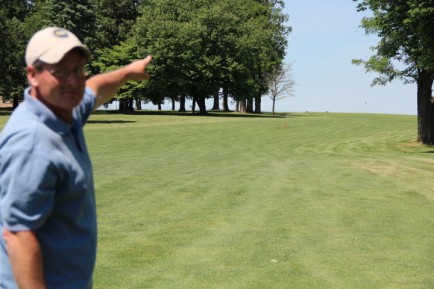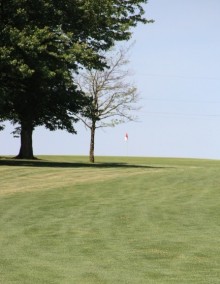
MYERSTOWN – (Editor’s note: What follows is the second installment of a ten-part series dedicated to identifying Lebanon County’s top ten golf holes, which last aired in the summer of 2016. Based on an informal survey of the locale’s top amateur players, the countdown strives to feature the ten truest tests of golf, rather than naming the most popular or most difficult holes.)
There’s a lot to be said for maturing, evolving and becoming the people we were meant to be. The same is true of a golf course, or more specifically a golf hole.
When a hole grows up and matures it can literally be a thing of beauty.
Take Number 15 at Lebanon Valley Golf Course for example, 530 yards of a par-five.
There was a time when the 15-20 trees that line the right side of the hole’s fairway weren’t much taller than a man, and therefore were about as menacing. A player could go right with his or her tee shot, or could go right with his or her second shot, and have a wide-open approach to the small green. A haven for birdies.
But that time has long since passed.
 “The tee shot’s the key,” said Kent Ulrich, general manager at Lebanon Valley. “But it doesn’t stop there. The second shot is important too. During tournaments, on Sunday, the pin is on the right front (of the green). If you’re behind the pin, good luck trying to putt that. It’s just a neat hole.
“The tee shot’s the key,” said Kent Ulrich, general manager at Lebanon Valley. “But it doesn’t stop there. The second shot is important too. During tournaments, on Sunday, the pin is on the right front (of the green). If you’re behind the pin, good luck trying to putt that. It’s just a neat hole.
“You used to be able to blaze away here (at Lebanon Valley),” Ulrich continued. “The trees didn’t matter. Now when you look at the fairway, they’re lined by mature pines and oaks. It’s not an easy golf course any more.”
“Number 15 has an elevated tee, and you can see the entire hole, which is a slight dog-leg to the right after 400 yards,” said Tony Deraco, the reigning Lebanon County Amateur champion and a long-time member at Lebanon Valley. “There are trees lining the right side of the fairway. The green is slightly elevated, with bunkers on the back and a false front.”
The ideal tee shot on Number 15 would hug the left side of the fairway, giving a player the most advantageous opening as possible. Even so, one is faced with a long and precise second attempt, which makes eagles improbable and birdies unlikely.
“When you think of Lebanon Valley’s par-fives, you want to make birdies on them,” said Ulrich. “But 15 is not your typical par-five at Lebanon Valley. If you hit your drive too short, you have no chance of getting there. A good drive gets you to within 170 or 180 yards of the green, but you’ve got to get through the opening.
 “They’re talking from the upper tees,” continued Ulrich. “You need a perfect tee shot on that hole to have a decent second shot at the green. If you’re on the right side of the fairway and you can’t hit a cut, you’re looking at trees.”
“They’re talking from the upper tees,” continued Ulrich. “You need a perfect tee shot on that hole to have a decent second shot at the green. If you’re on the right side of the fairway and you can’t hit a cut, you’re looking at trees.”
Number 15’s green is not large and is protected by an elevated skirt in the front.
“That’s a good hole,” said Ulrich, who, with the trees, grew up at Lebanon Valley. “And number six is a good hole. Six is a bear of a par-three.”
Lebanon Valley Golf Course, which plays to a par of 71 and to 6,136 yards from the back tees, was built in 1956 by Dave Boyer, Marlin Gibble and Allen Brown.
“The perception of Lebanon Valley has definitely changed,” said Ulrich, who has witnessed the building of the par-three 14th, and a new clubhouse, pavilion and bar area during his time there. “The yardage is here. The trees are big. You hit it straight, you’re OK. But if you miss the fairway, you’re going to pay for it. And there’s some small greens here.
“The trees have matured,” concluded Ulrich. “When they built the course they planted oodles of those pin oaks in the fairways.”
